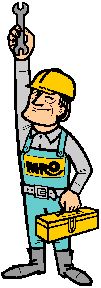
Checking coupling alignment with an infra-red pyrometer
Problem: I've heard that an infra-red temperature instrument can be used for coupling diagnostics. How?Solution: People are always wondering how they can quickly check if a coupling is aligned properl...
December 1, 2001 | By MRO Magazine

Problem: I’ve heard that an infra-red temperature instrument can be used for coupling diagnostics. How?
Solution: People are always wondering how they can quickly check if a coupling is aligned properly. Some companies have invested a lot of money in tools that will help them align couplings and determine if a coupling is out of alignment. The two most commonly used systems today to check for coupling misalignment are the laser coupling alignment tool and current analysis tools located at the electric motor. Not all companies can afford to invest in these types of systems.
A quick and dirty way to determine if your coupling is aligned correctly is with the use of an infra-red camera or an infra-red pin-point temperature gauge. Both of these tools will allow you to quickly determine if the coupling is aligned properly.
The procedure is as follows:
Start-up after a repair
Take the temperature of the coupling halves at the 3, 6, 9 and 12 o’clock positions. Also, note the temperature of each shaft.
Calculate the normal operating temperature of the component.
Start the motor and check the temperature using the infrared device at each half of the coupling at the 3, 6, 9, and 12 o’clock positions, and also check the temperature of the shaft on the motor and on the drive unit. Write down the temperature readings as you take them.
All of the readings should be within a couple of degrees of each other. Continue at one-minute intervals until the unit is up to operating temperature.
If the coupling is hotter than the shafts during start-up, then you have a coupling that is misaligned. If you have a major temperature differential between any of the clock readings, it also means that your coupling is misaligned.
Notes: This process will not work on couplings that use plastic, rubber or mica media to transfer power between coupling halves. Fluid couplings lag slightly in temperature when compared to the shafts when starting from cold. You also need to understand the internal functioning of the coupling. Some couplings will generate their own heat because of their design. You must take this into consideration.
Mr. O’s thanks go to Stan Shantz, co-founder, Global Benchmarking Organization Inc., Cambridge, Ont., for this handy tip.
was thinking about the Internet a lot around the time many readers were receiving the previous issue of this magazine in the mail. It was Sept. 11, 2001, a day now embedded into the lifelong memories of millions of people around the world.
On that Tuesday of Terror, a friend of ours from New York City was visiting her parents near Toronto. When she heard the news of the terrorist attacks, she immediately tried to contact her husband, an industry analyst in Manhattan. No luck, as all the phones in the city’s core were either jammed or down.
device from RIM Technologies–a Canadian development, by the way–he was able to communicate his whereabouts as he struggled through the dust-layered city to pick up his children and get them home. Thanks to the Internet, we were able to relay messages to and from his wife until he was able to get out of Manhattan and reach a working telephone.
It’s one small example of the benefit of the Internet. And although the need for reliable communications in the everyday industrial environment may seem small in comparison to the need for it on Sept. 11, the Internet and its World Wide Web provide a welcome connection, day in and day out, to a vast realm of contacts, information and resources literally throughout the world.
I doubt we’ve even come close to exploiting the full communications potential of the Net, in induBut more and more, developments in software, technology and app us closer to a new way of doing things.
Maintenance expert and regular contributor Morris Berengut explores one of these new applications in this issue with his examination of computerized maintenance management systems (CMMS) that reside on the Internet. No huge programs to install. No worries about networking computers in different plants. No troublesome data backups to be concerned about.
However, for all its advantages, there are issues with this method of maintenance management that will be of concern to some potential users. The article gives you all the pros and cons.
But more than that, it points to the future of our world. Even if you aren’t ready to run your maintenance department using a remote web server, you sking about what this technolog
It’s an interesting future we have to look forward to. Whether it’s co-ordinating all your maintenance operations from a laptop computer and a wireless modem out in the field, or simply letting loved ones know that you’re safe and sound, the Internet is sure to be an increasingly important part of our lives for years to come.
If you have any thoughts on this topic, I invite you to share them with us. Of course, I recommend that you use the Internet and send your note by e-mail to broebuck@corporate.southam.ca.
Bill Roebuck, Editor
Do you have a solution for a maintenance problem? Send it in and if it’s published, we’ll send you a free Mr. O Problem Solver T-shirt and $35.00. Include your address and telephone number, print complete details, and add a sketch to help explain your tip. Send your ideas to Mr. O, Machinery & Equipment MRO, 1450 Don Mills Rd., Don Mills, Ont. M3B 2X7.
